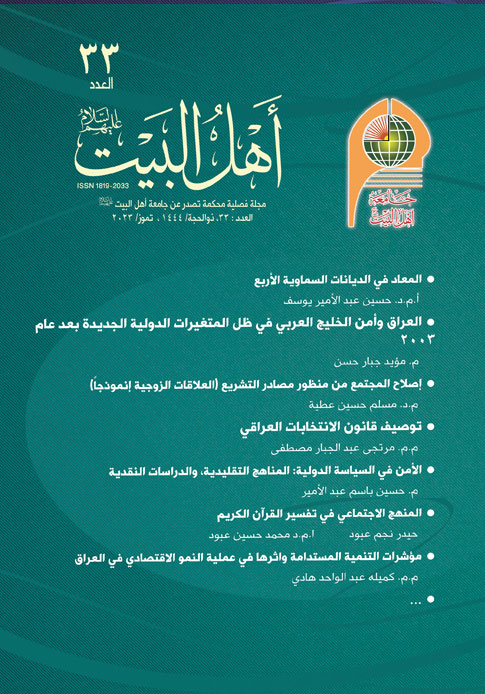Abstract
The image consists of many components such as information, facts, knowledge, psychological attitudes, perceptions, and fixed patterns. It is acquired through the individual's accumulated experience over the years of their life. Media has become the most important source for shaping this image, especially after the technological development and the communication and information revolution we are currently experiencing. Its effectiveness and influence on the public are increasing, which in turn leads to the creation of opinions and attitudes that form the mental image targeted toward people, things, organizations, and countries. The role of the media is no longer limited to transmitting information only; rather, it now plays a significant role in shaping the image of peoples, countries, and organizations alike.
Therefore, this research attempts to present a comprehensive picture of the public's perception in conflict zones, their opinions, and their attitudes toward war correspondents. Thus, the research problem is represented in answering a central question:
What is the prevailing image of the war correspondent among the public in conflict zones?
The research aims to uncover the nature of the mental image held by the public about the war correspondent in conflict zones (whether negative or positive). It also aims to identify the factors that led to the formation of that image, as well as to discover the extent to which the public in conflict zones follows war correspondents.
The researcher used the survey method in order to collect, classify, and analyze the data. A questionnaire was used to identify the respondents' answers regarding the research problem under study. The questionnaire was distributed among audiences from the provinces where armed conflicts took place, considering that this audience represents the study sample from the conflict zones targeted in this research. They are viewed as an important and relevant segment for the study. The total number of respondents reached (400).
Therefore, this research attempts to present a comprehensive picture of the public's perception in conflict zones, their opinions, and their attitudes toward war correspondents. Thus, the research problem is represented in answering a central question:
What is the prevailing image of the war correspondent among the public in conflict zones?
The research aims to uncover the nature of the mental image held by the public about the war correspondent in conflict zones (whether negative or positive). It also aims to identify the factors that led to the formation of that image, as well as to discover the extent to which the public in conflict zones follows war correspondents.
The researcher used the survey method in order to collect, classify, and analyze the data. A questionnaire was used to identify the respondents' answers regarding the research problem under study. The questionnaire was distributed among audiences from the provinces where armed conflicts took place, considering that this audience represents the study sample from the conflict zones targeted in this research. They are viewed as an important and relevant segment for the study. The total number of respondents reached (400).
Keywords
Conflict zone audience.
Image
war correspondent
Abstract
تتكون الصورة من مكونات كثيرة من المعلومات والحقائق والمعارف والاتجاهات النفسية والتصورات والأنماط الجامدة، ويتم اكتسابها عن طريق الخبرة المتراكمة لدى الفرد عبر سنوات حياته، وأصبحت وسائل الإعلام أهم مصادر تشكيل الصورة لاسيما بعد التطور التكنولوجي وثورة الاتصالات والمعلومات التي نعيشها الآن، وتتزايد فاعليتها وقدراتها التأثيرية على الجمهور الذي يؤدي بالتالي إلى خلق آراء واتجاهات تكوّن الصورة الذهنية التي تستهدفها تجاه الأشخاص والأشياء والمنظمات والدول فيما بعد، ولم يُعدّ دور وسائل الإعلام يقتصر على نقل المعلومات فقط، بل أصبحت تؤدي دوراً مهماً في تشكيل الصورة للشعوب والدول والمنظمات على حد سواء. لذا يحاول هذا البحث أن يعطي صورة متكاملة عن نظرة الجمهور في مناطق النزاع وآرائهم ومواقفهم تجاه المراسلين الحربيين، وبذلك تتمثل مشكلة البحث في الاجابة عن تساؤل رئيس يتمحور في: (ما الصورة السائدة لدى جمهور مناطق النزاع عن المراسل الحربي؟)
ويهدف البحث الى الكشف عن طبيعة الصورة الذهنية التي يحملها الجمهور عن المراسل الحربي في مناطق النزاع (سلبية ام ايجابية)، كما يهدف البحث الى معرفة العوامل التي ادت الى تشكيل تلك الصورة عن المراسل الحربي لدى جمهور مناطق النزاع، اكتشاف مدى متابعة جمهور مناطق النزاع للمراسلين الحربيين، وقد استخدم الباحث المنهج المسحي بهدف جمع المعلومات وتبويبها وتحليلها،واستخدم الباحث استمارة استبيان للتعرف على استجابات المبحوثين بخصوص مشكلة البحث التي نحن بصدد دراستها، وقد وزع الباحث الاستبانة بالنسبة جمهور المحافظات التي دارت بها الصراعات الحربية باعتبار أن هؤلاء الجمهور يمثلون عينة المجتمع في مناطق النزاع المستهدف من الدراسة، بحكم انهم شريحة مهمة ومستهدفة من هذا البحث والذي بلغ عددهم (400) مبحوث.
ويهدف البحث الى الكشف عن طبيعة الصورة الذهنية التي يحملها الجمهور عن المراسل الحربي في مناطق النزاع (سلبية ام ايجابية)، كما يهدف البحث الى معرفة العوامل التي ادت الى تشكيل تلك الصورة عن المراسل الحربي لدى جمهور مناطق النزاع، اكتشاف مدى متابعة جمهور مناطق النزاع للمراسلين الحربيين، وقد استخدم الباحث المنهج المسحي بهدف جمع المعلومات وتبويبها وتحليلها،واستخدم الباحث استمارة استبيان للتعرف على استجابات المبحوثين بخصوص مشكلة البحث التي نحن بصدد دراستها، وقد وزع الباحث الاستبانة بالنسبة جمهور المحافظات التي دارت بها الصراعات الحربية باعتبار أن هؤلاء الجمهور يمثلون عينة المجتمع في مناطق النزاع المستهدف من الدراسة، بحكم انهم شريحة مهمة ومستهدفة من هذا البحث والذي بلغ عددهم (400) مبحوث.
Keywords
الصورة، المراسل الحربي، جمهور مناطق النزاع
